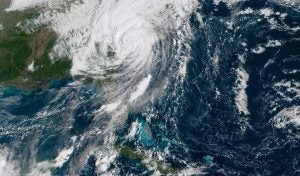Natural disasters can devastate farm families’ livelihood, wreaking havoc on farm infrastructure, destroying crops and killing livestock. An economist with the Alabama Cooperative Extension System said the most significant threats in many of the southern and southeastern states come from hurricanes and their aftereffects. Other types of severe weather are prominent elsewhere in the country.
“The nature of their job means that farmers face inherent risks,” said Adam Rabinowitz, who is also an Auburn University assistant professor of agricultural economics. “There are ways to prepare and a number of government programs to aid recovery.”
Many of these programs are administered by the United States Department of Agriculture’s Farm Service Agency.
Shnequie Bowman-Greene, Alabama FSA chief agricultural program specialist, was recently a guest on Episode 25 of the Alabama Crops Report Podcast. She said when disaster affects agriculture, the FSA’s role is to assess damage.
“After the disaster, we do loss assessments and then track those losses at a county level,” she said. “The major role of tracking is to guide disaster designation. If we have one or more crops with a 30 percent or greater loss, FSA forwards that information to the Secretary of Agriculture and requests a disaster designation.”
What to do
Rabinowitz offered these suggestions for farmers confronting the aftermath of a disaster.
- Collect documentation. Before starting any cleanup activity, take time-stamped photographs of damage and losses that have occurred.
- Notify the local Farm Service Agency (FSA) about losses. This helps FSA prepare a county Loss Assessment Report, vital to a county being designated as an agricultural disaster area.
- Contact crop insurance agent to report losses or damages. Do this before beginning cleanup activities to ensure proper documentation. Notify the agent within 72 hours of the discovery of a loss. Farmers should also provide a signed written notice of losses and damages to their agent within 15 days of the loss.
- Producers who have Noninsured Crop Disaster Assistance (NAP) or are eligible for other disaster assistance programs should contact the local FSA office. Do this before starting any cleanup activities to ensure everything is documented correctly and a waiver can be issued before cleanup.

Important disaster resources
“The USDA recovery website contains valuable resources and farmers should review it in case of a natural disaster,” he said. Find that site here.
Sydney Griffin, an FSA agricultural program specialist who was also a guest on the crops podcast, said farmers should find a disaster assistance recovery tool on the site useful.
“The tool will help farmers choose which type of programs that FSA has that might offer benefits after they have suffered these weather events,” Griffin said.
Rabinowitz has published a factsheet listing a number of disaster assistance programs that may aid those applying for assistance due to agricultural losses.
- Crop Insurance
- Noninsured Crop Disaster Assistance Program
- Tree Assistance Program
- Emergency Assistance for Livestock, Honeybees, and Farm-Raised Fish
- Livestock Forage Disaster Program
- Emergency Conservation Program
- Livestock Indemnity Program
- Emergency Forest Restoration Program
- Emergency Watershed Protection Program
- Disaster Set-Aside Program
- Emergency Loan Program
More help may become available
Bowman-Greene added that additional programs often become available, particularly in natural disasters with widespread damage.
Rabinowitz and Bowman-Greene agree that gathering documentation and following FSA guidance are crucial to navigating the disaster assistance process successfully.


